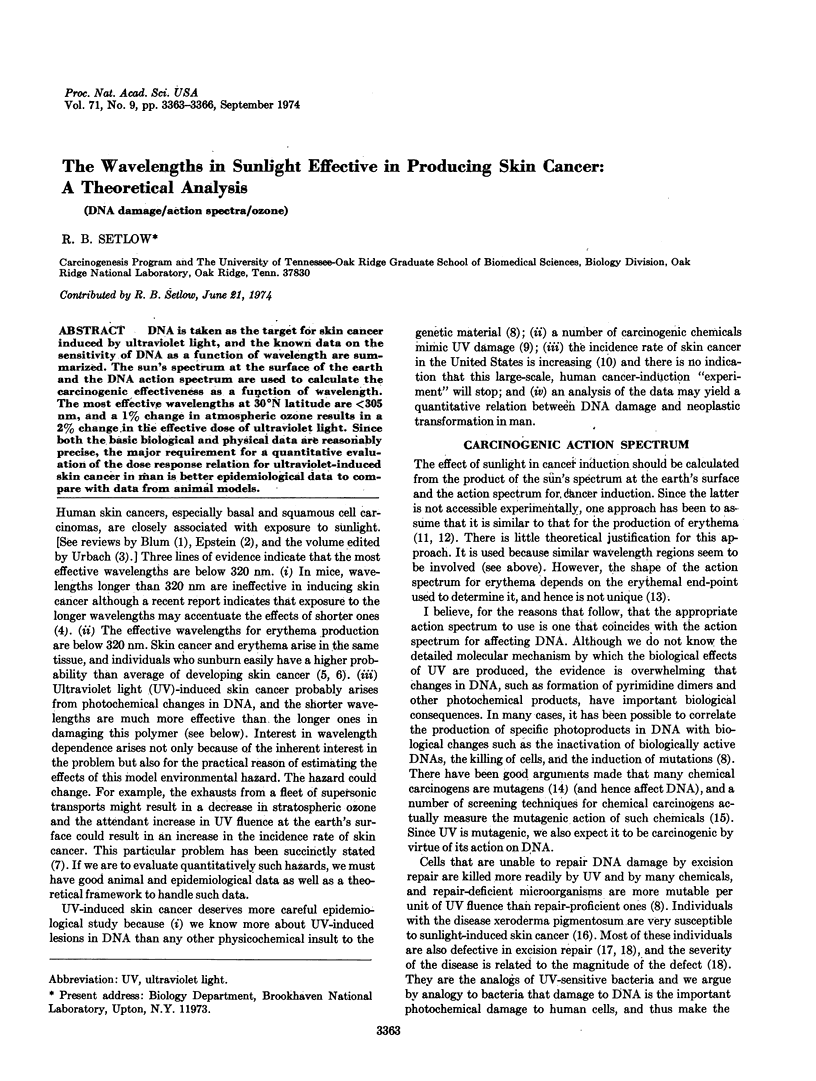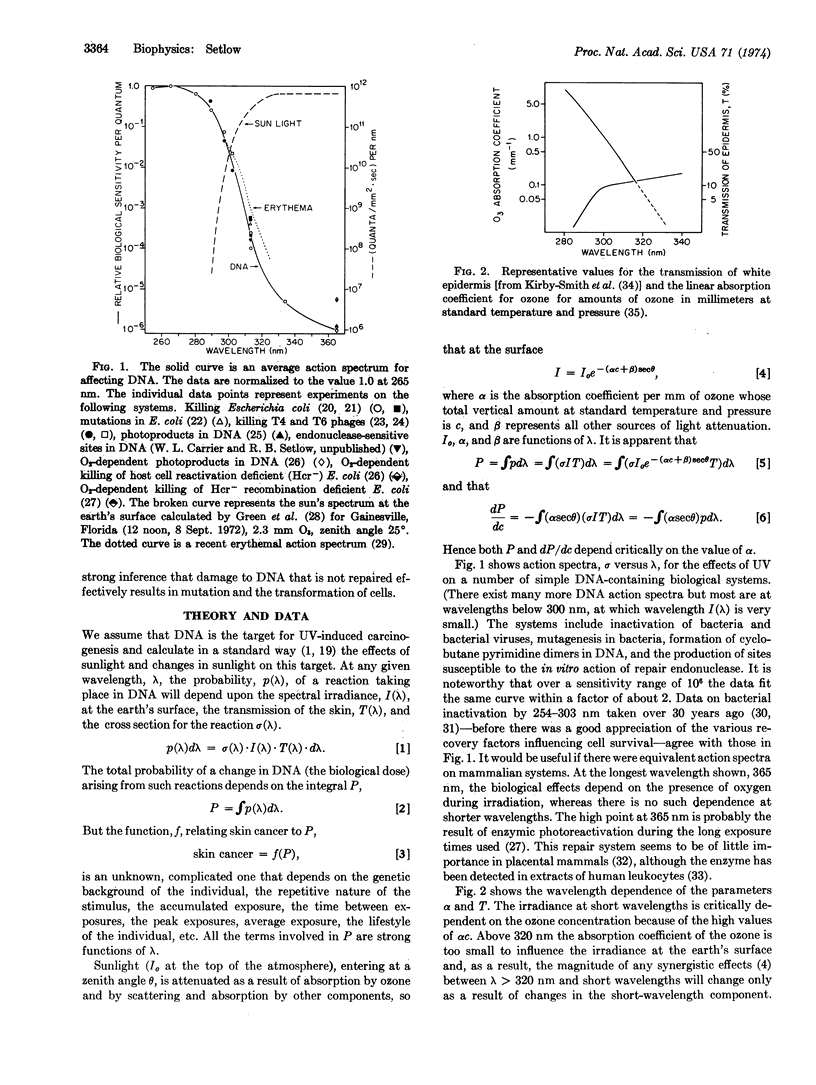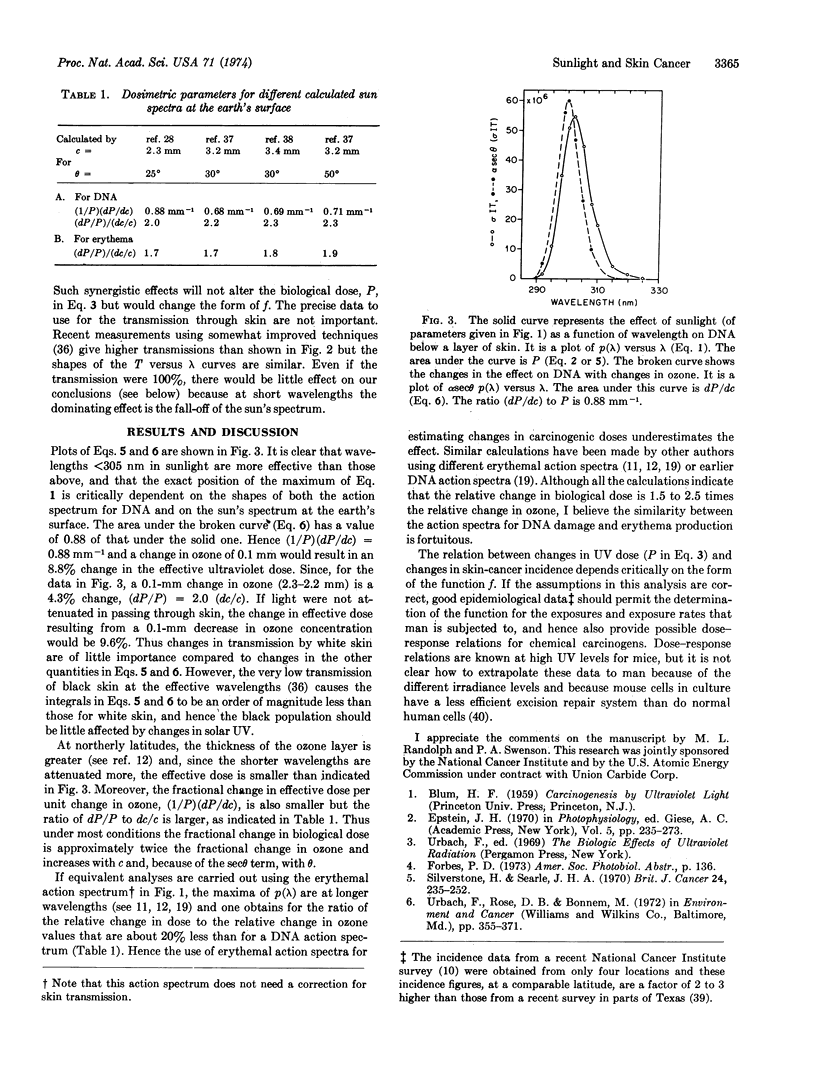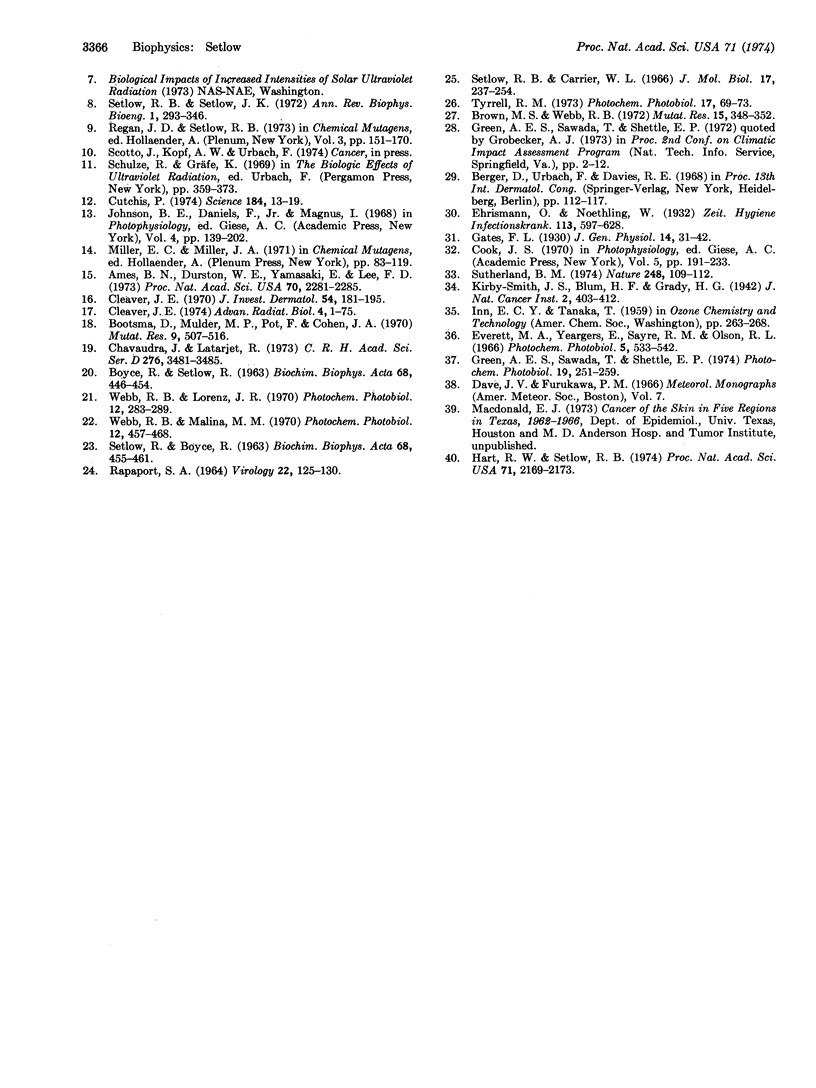Abstract
DNA is taken as the target for skin cancer induced by ultraviolet light, and the known data on the sensitivity of DNA as a function of wavelength are summarized. The sun's spectrum at the surface of the earth and the DNA action spectrum are used to calculate the carcinogenic effectiveness as a function of wavelength. The most effective wavelengths at 30°N latitude are <305 nm, and a 1% change in atmospheric ozone results in a 2% change in the effective dose of ultraviolet light. Since both the basic biological and physical data are reasonably precise, the major requirement for a quantitative evaluation of the dose response relation for ultraviolet-induced skin cancer in man is better epidemiological data to compare with data from animal models.
Keywords: DNA damage, action spectra, ozone
Full text
PDF



Selected References
These references are in PubMed. This may not be the complete list of references from this article.
- Ames B. N., Durston W. E., Yamasaki E., Lee F. D. Carcinogens are mutagens: a simple test system combining liver homogenates for activation and bacteria for detection. Proc Natl Acad Sci U S A. 1973 Aug;70(8):2281–2285. doi: 10.1073/pnas.70.8.2281. [DOI] [PMC free article] [PubMed] [Google Scholar]
- Bootsma D., Mulder M. P., Cohen J. A., Pot F. Different inherited levels of DNA repair replication in xeroderma pigmentosum cell strains after exposure to ultraviolet irradiation. Mutat Res. 1970 May;9(5):507–516. doi: 10.1016/0027-5107(70)90035-7. [DOI] [PubMed] [Google Scholar]
- Brown M. S., Webb R. B. Photoreactivation of 365 nm inactivation in Escherichia coli. Mutat Res. 1972 Jul;15(3):348–352. doi: 10.1016/0027-5107(72)90080-2. [DOI] [PubMed] [Google Scholar]
- Chavaudra J., Latarjet R. Influence des variations de l'ozone atmosphérique sur certaines activités biologiques du rayonnement ultraviolet solaire. C R Acad Sci Hebd Seances Acad Sci D. 1973 Jun 25;276(26):3481–3485. [PubMed] [Google Scholar]
- Cleaver J. E. DNA damage and repair in light-sensitive human skin disease. J Invest Dermatol. 1970 Mar;54(3):181–195. doi: 10.1111/1523-1747.ep12280225. [DOI] [PubMed] [Google Scholar]
- Cook J. S. Photoreactivation in animal cells. Photophysiology. 1970;5:191–233. [PubMed] [Google Scholar]
- Cutchis P. Stratospheric ozone depletion and solar ultraviolet radiation on Earth. Science. 1974 Apr 5;184(4132):13–19. doi: 10.1126/science.184.4132.13. [DOI] [PubMed] [Google Scholar]
- Epstein J. H. Ultraviolet carcinogenesis. Photophysiology. 1970;5:235–273. [PubMed] [Google Scholar]
- Everett M. A., Yeargers E., Sayre R. M., Olson R. L. Penetration of epidermis by ultraviolet rays. Photochem Photobiol. 1966 Jul;5(7):533–542. doi: 10.1111/j.1751-1097.1966.tb09843.x. [DOI] [PubMed] [Google Scholar]
- Hart R. W., Setlow R. B. Correlation between deoxyribonucleic acid excision-repair and life-span in a number of mammalian species. Proc Natl Acad Sci U S A. 1974 Jun;71(6):2169–2173. doi: 10.1073/pnas.71.6.2169. [DOI] [PMC free article] [PubMed] [Google Scholar]
- SETLOW R., BOYCE R. The action spectra for ultraviolet-light inactivation of systems-containing 5-bromouracil-substituted deoxyribonucleic acid. II. Bacteriophage T4. Biochim Biophys Acta. 1963 Mar 26;68:455–461. doi: 10.1016/0006-3002(63)90167-7. [DOI] [PubMed] [Google Scholar]
- Setlow R. B., Carrier W. L. Pyrimidine dimers in ultraviolet-irradiated DNA's. J Mol Biol. 1966 May;17(1):237–254. doi: 10.1016/s0022-2836(66)80105-5. [DOI] [PubMed] [Google Scholar]
- Setlow R. B., Setlow J. K. Effects of radiation on polynucleotides. Annu Rev Biophys Bioeng. 1972;1:293–346. doi: 10.1146/annurev.bb.01.060172.001453. [DOI] [PubMed] [Google Scholar]
- Silverstone H., Searle J. H. The eqpidemilogy of skin cancer in Queensland: the influence of phenotype and environment. Br J Cancer. 1970 Jun;24(2):235–252. doi: 10.1038/bjc.1970.27. [DOI] [PMC free article] [PubMed] [Google Scholar]
- Sutherland B. M. Photoreactivating enzyme from human leukocytes. Nature. 1974 Mar 8;248(5444):109–112. doi: 10.1038/248109a0. [DOI] [PubMed] [Google Scholar]
- Tyrrell R. M. Induction of pyrimidine dimers in bacterial DNA by 365 nm radiation. Photochem Photobiol. 1973 Jan;17(1):69–73. doi: 10.1111/j.1751-1097.1973.tb06334.x. [DOI] [PubMed] [Google Scholar]
- Webb R. B., Lorenz J. R. Oxygen dependence and repair of lethal effects of near ultraviolet and visible light. Photochem Photobiol. 1970 Oct;12(4):283–289. doi: 10.1111/j.1751-1097.1970.tb06060.x. [DOI] [PubMed] [Google Scholar]
- Webb R. B., Malina M. M. Mutagenic effects of near ultraviolet and visible radiant energy on continuous cultures of escherichia coli. Photochem Photobiol. 1970 Dec;12(6):457–468. doi: 10.1111/j.1751-1097.1970.tb06078.x. [DOI] [PubMed] [Google Scholar]


